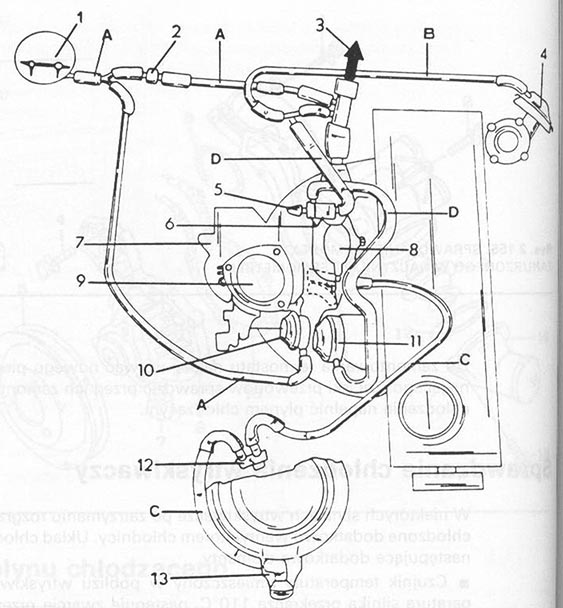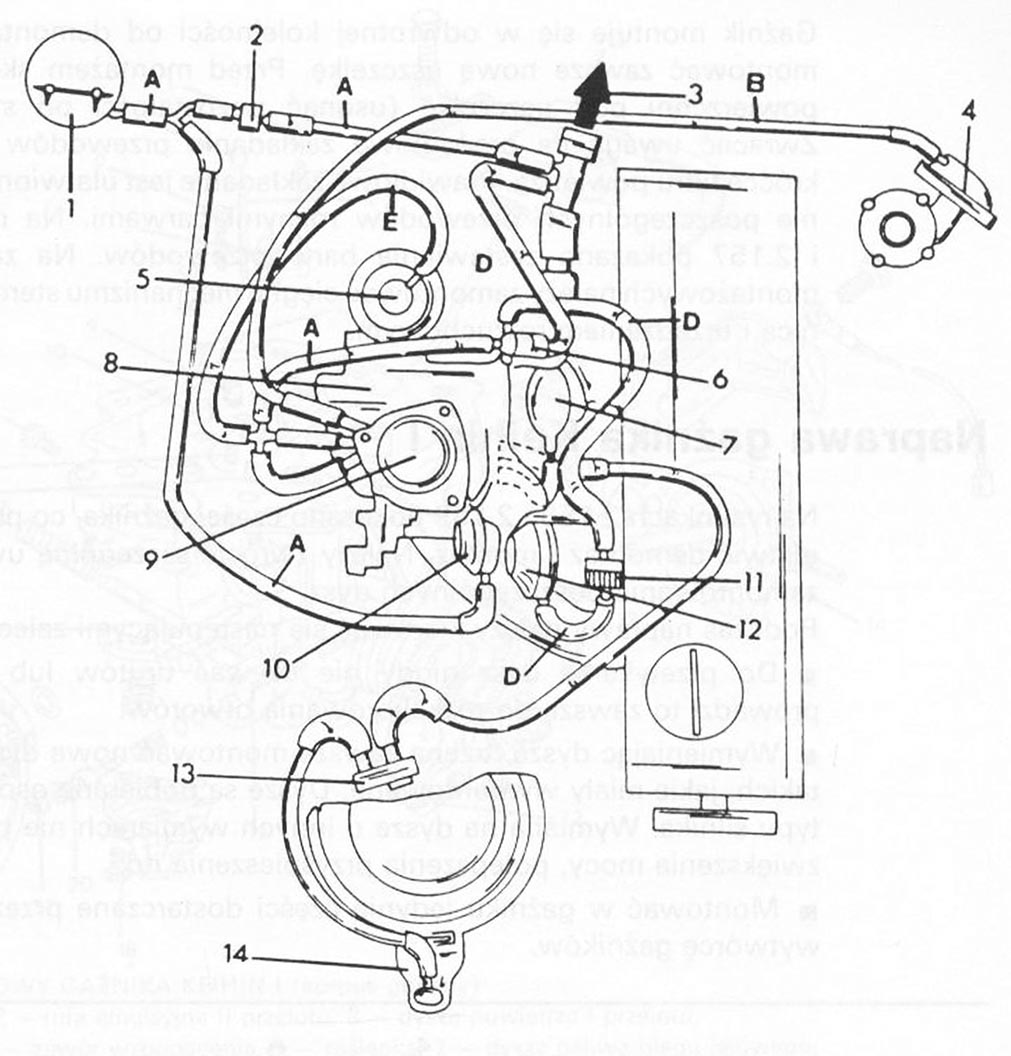Keihin I Carburetor Removal and Installation
List of carburetors and engines, in which the carburetors are mounted, can be found in the table "Technical characteristics”. The carburettors used are of the two-hole type 26-30 DC. The carburetor is equipped with actuators to control the automatic starter and the opening of the second pass throttle, and also a heat switch for heating the intake manifold. The heater of the suction corrector heater is screwed into the lower part of the collector. The carburetor is connected to a thermostat in the air filter. The carburetor works with a vacuum air reservoir separated from the carburetor. The air is used to control the operation of the actuators. The tightness of the vacuum hoses has an influence on the correct operation of the carburetor.
 Lynx. 1 KEIHIN CARBURETOR LOCATION I
Lynx. 1 KEIHIN CARBURETOR LOCATION I
1 – vacuum tank
2 – reducing connector (green)
3 – to the servo of the brake system
4 – Ignition distributor vacuum regulator
5 – vent cap
6 – closed-throttle speed governor on cars with manual gearbox or idle speed boost valve on cars with automatic gearbox
7 – intake manifold
8 – II cruise throttle actuator
9 – Keihin I carburetor
10 – pull down actuator”
11 – regulator actuator (6)
12 – temperature regulator
13 – controller
A – light green b – black C. – transparent D – brown
In the picture 1 shows the arrangement of vacuum lines in cars exported to all countries except Switzerland. In the picture 2 shows the laying of vacuum lines in cars exported to Switzerland. The colors of the wires are marked in capital letters in the figures.
■ Remove the air filter. Pay attention to how the air pipes are connected to the filter, so that they can be connected in the same way during assembly. The most correct way is to disconnect the hose from the filter cover (after releasing the spring clips) and removing the filter cartridge, and then disassembly of the remaining cables with protections.
■ Disconnect the fuel lines from the carburetor: feeding and draining excess fuel to the tank.
■ Disconnect the electric wires for the fuel shutoff valve to the idle system (pull out the plug).
■ Disconnect the carburetor control cable. To do this, unscrew both bracket nuts on the carburetor and remove the bracket cable. Pay attention to the lower ground cable. Remove the cable from the throttle lever tab. Do not remove the clamping clamp.
■ Disconnect and remove the starter actuator cable from the hitch on the carburetor.
■ Remove the vacuum lines from the starter and throttle actuators.
■ Disconnect the vacuum hose leading to the ignition distributor from the carburetor.
■ Disconnect the electric wire that connects the carburetor to the heater (a heater) intake manifold.
■ Unscrew and remove the carburetor from the intake manifold.
■ Block the opening in the intake manifold to prevent contamination from accidentally entering the engine interior.
The carburetor is installed in the reverse order of disassembly. Always install a new gasket under the carburetor. Before assembly, check the condition of the surface for the seal (remove any old gasket residue). Pay attention to the correct positioning of the inlet pipes on the air filter stubs. Correct donning is made easier by marking the individual wires with different colors. The figures show the cable colors. At the end of the assembly works, the cables of the throttle control mechanism and the starting device should be installed.
 Lynx. 2. KEIHIN CARBURETOR LOCATION I – IN CARS EXPORTED TO SWITZERLAND (with flue gas return device)
Lynx. 2. KEIHIN CARBURETOR LOCATION I – IN CARS EXPORTED TO SWITZERLAND (with flue gas return device)
1 – vacuum tank
2 – reducing connector (green)
3 – to the servo of the brake system
4 – Ignition distributor vacuum regulator
5 – vent cap
6 – closed-throttle speed governor on vehicles with a manual gearbox
7 – II cruise throttle actuator
8 – intake manifold
9 – Keihin I carburetor
10 – actuator ,,pull down”
11 – delay valve (mounted with the white side to the regulator 6)
12 – regulator actuator (6)
13 – temperature regulator
14 – controller – A – light green b – black C. – transparent D – brown E – Gray